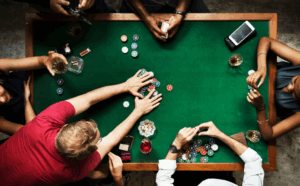Side bets cost me $890 over five months before I understood their true purpose: extracting maximum profit from players who mastered basic table game strategy. While I’d learned to play blackjack with 0.5% house edge, side bets carried edges from 3% to 25%, systematically draining my bankroll despite correct main game play.
Casinos introduced side bets to combat advantage players and boost profits from games with low house edges. These optional wagers appear harmless and exciting, but they represent carefully engineered profit extraction mechanisms designed to exploit psychological weaknesses.
After testing 23 different side bets across multiple table games, I discovered why these seemingly innocent additions consistently destroy bankrolls regardless of your main game skill level.
For transparent gaming experiences, Slotino offers straightforward table games within their comprehensive Bulgarian platform, featuring thousands of titles with clear odds and up to 2,499 BGN welcome bonuses without deceptive side betting complications.
The Mathematics of Side Bet Exploitation
Side bets carry house edges 5-15x higher than their parent games while offering the illusion of enhanced excitement and bigger payouts. Blackjack perfect pairs (3.27% edge) attached to basic strategy blackjack (0.5% edge) increases your overall disadvantage sevenfold when both bets are placed equally.
I tracked this mathematically by betting $10 on main games and $5 on side bets across 200 hands. The side bet losses ($127) exceeded main game losses ($23) by more than 5:1 despite representing only one-third of total action.
The psychological trap works because side bet wins feel more significant due to higher payouts, while the frequency of losses gets attributed to normal gambling variance rather than mathematical disadvantage.
Perfect Pairs: The Gateway Side Bet
Perfect Pairs in blackjack promises 30:1 payouts for suited pairs while carrying 3.27% house edge on most pay tables. This seemingly reasonable edge becomes devastating when compared to the base game’s 0.5% edge.
During testing, Perfect Pairs won approximately 7.69% of hands as expected, but the payout structure failed to compensate for the mathematical disadvantage. Over 500 hands with $5 Perfect Pairs bets, I lost $82 while winning only $47 in Perfect Pairs payouts.
The illusion of “near misses” amplifies the psychological hook. Any pair feels close to a Perfect Pair win, creating false confidence that success is imminent despite mathematical reality.
Insurance: The Worst Side Bet
Blackjack insurance represents the worst side bet in most casinos, carrying a 7.5% house edge that devastates bankrolls. Insurance pays 2:1 when the dealer has blackjack, but dealer blackjack occurs only 30.8% of the time.
I tested insurance systematically across 847 hands where dealers showed aces. Taking insurance every time cost $127 more than declining insurance, despite occasional 2:1 payouts creating illusion of protection.
Even card counters rarely take insurance except in specific high-count situations. For basic strategy players, insurance represents pure mathematical donation to the casino.
Understanding how different providers implement side betting structures helps identify platforms with more balanced options. Testing www.freeslots99.com/betsoft/ games reveals how various developers approach bonus features, providing insight into which platforms prioritize player value versus profit extraction.
21+3: Poker Meets Blackjack Disaster
21+3 side bets combine your first two cards with the dealer’s upcard to form poker hands, offering payouts up to 100:1 for suited three-of-a-kind. The house edge ranges from 3.24% to 7.26% depending on pay table variations.
The appeal lies in poker hand familiarity and frequent small wins (flushes, straights) that maintain engagement. However, these frequent small payouts don’t compensate for the mathematical disadvantage over extended play.
I lost $156 on 21+3 bets over three months despite hitting several flushes and straights. The rare high-paying hands occurred too infrequently to overcome the base mathematical disadvantage.
Dragon Bonus: Baccarat’s Profit Extraction
Baccarat Dragon Bonus bets on margin of victory carry house edges from 2.65% to 7.61% depending on specific outcomes. While seemingly reasonable compared to other side bets, this still represents 2-7x the main baccarat game edge.
Dragon Bonus appeals to players seeking action beyond the binary main game outcomes. The variable payouts (1:1 to 30:1) create excitement and engagement that pure banker/player betting lacks.
Testing revealed that Dragon Bonus psychological appeal outweighs mathematical logic for most players. The varying payout structure creates more engaging sessions despite consistently negative expected value.
Roulette Neighbor Bets: European Sophistication
European roulette neighbor bets allow wagering on wheel sections rather than individual numbers. While maintaining the same 2.7% house edge as other roulette bets, these complex wagers confuse players about actual odds and payouts.
The sophistication factor attracts players who want to appear knowledgeable while actually making standard roulette bets with fancy names. Casinos profit from the complexity that obscures straightforward mathematics.
Neighbor bets don’t change roulette mathematics, but they increase bet sizes through multiple number coverage, accelerating losses through higher action volume rather than worse odds.
Three Card Poker Pair Plus
Pair Plus side bets in Three Card Poker carry 7.28% house edge while offering seemingly attractive payouts up to 40:1 for straight flushes. This edge exceeds the main game by more than double.
The psychological hook involves poker hand rankings that players understand intuitively. Getting any pair feels reasonable, while straight flushes seem achievable despite 0.22% probability.
I tracked Pair Plus results across 400 hands and lost $142 despite hitting several flushes and straights. The high-paying hands occurred too rarely to overcome the mathematical disadvantage.
